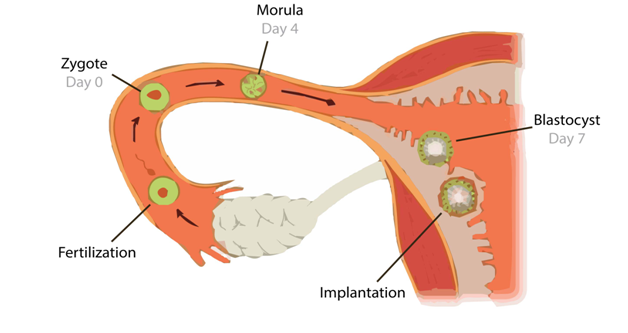
Which one is not a character of the hemochorial placenta?
(a) ${ CO }_{ 2 }$ and excretory products pass from foetus to mother’s body
(b) ${ O }_{ 2 }$ and nutrients from the mother’s body enter the foetus
(c) Chorion villi are covered by blood sinuses of mother
(d) It protects the foetus from mechanical shocks
Answer
581.4k+ views
Hint: The placenta is a brief connection which acts as a barrier between the foetus and maternal tissues. It is observed in Eutherians or placental mammals which give birth to live ones.
Complete answer:
Eutherians retain the embryos in the uterus or womb till an advanced stage which could be made possible with the development of the placenta. In humans and rodents, the hemochorial placenta is developed wherein the chorion villi originated from trophoblast of the foetus invades the maternal endothelium. Thus, the chorion villi are directly covered by the blood sinuses of the mother. Placenta also helps in the exchange of gases between the two as well as the elimination of nitrogenous wastes from the foetus.
Additional Information:
- After fertilisation, a series of rapid mitotic divisions called cleavage takes place where the cytoplasm of the zygote is divided equally among numerous smaller cells or morula.
- Morula is succeeded by the blastula stage. The blastula is composed of blastomeres which are arranged in an outer layer called trophoblast and an inner layer called inner cell mass. After around one week the blastula is embedded in uterine endometrial lining by the trophoblast cells.
- Around the time of implantation, the inner cell mass of the blastocyst forms a flat disc with an upper layer of cells, the epiblast and a lower layer, the hypoblast. Epiblast further divides to produce a human embryo.
- The placenta is formed by the association of foetus’ trophoblast and mesodermal cells from epiblast with mother’s endometrial tissue.
- The embryo is enveloped by an amniotic sac which is filled with an amniotic fluid to protect the growing embryo from any mechanical shock.

So, the correct answer is ‘protects the foetus from mechanical shocks.’
Note: - The endometrium is the uterine layer or wall on which implantation occurs. Its thickness considerably increases during ovulation to embed the incoming blastula in case the fertilisation occurs.
- Chorion is developed from the further division of trophoblast during implantation. It invades the endometrium of the mother’s uterus forming chorionic villi.
- Implantation is followed by the gastrulation stage wherein the three germ layers are originated by the rearrangement of cells into endoderm, mesoderm and ectoderm.
Complete answer:
Eutherians retain the embryos in the uterus or womb till an advanced stage which could be made possible with the development of the placenta. In humans and rodents, the hemochorial placenta is developed wherein the chorion villi originated from trophoblast of the foetus invades the maternal endothelium. Thus, the chorion villi are directly covered by the blood sinuses of the mother. Placenta also helps in the exchange of gases between the two as well as the elimination of nitrogenous wastes from the foetus.
Additional Information:
- After fertilisation, a series of rapid mitotic divisions called cleavage takes place where the cytoplasm of the zygote is divided equally among numerous smaller cells or morula.
- Morula is succeeded by the blastula stage. The blastula is composed of blastomeres which are arranged in an outer layer called trophoblast and an inner layer called inner cell mass. After around one week the blastula is embedded in uterine endometrial lining by the trophoblast cells.
- Around the time of implantation, the inner cell mass of the blastocyst forms a flat disc with an upper layer of cells, the epiblast and a lower layer, the hypoblast. Epiblast further divides to produce a human embryo.
- The placenta is formed by the association of foetus’ trophoblast and mesodermal cells from epiblast with mother’s endometrial tissue.
- The embryo is enveloped by an amniotic sac which is filled with an amniotic fluid to protect the growing embryo from any mechanical shock.

So, the correct answer is ‘protects the foetus from mechanical shocks.’
Note: - The endometrium is the uterine layer or wall on which implantation occurs. Its thickness considerably increases during ovulation to embed the incoming blastula in case the fertilisation occurs.
- Chorion is developed from the further division of trophoblast during implantation. It invades the endometrium of the mother’s uterus forming chorionic villi.
- Implantation is followed by the gastrulation stage wherein the three germ layers are originated by the rearrangement of cells into endoderm, mesoderm and ectoderm.
Recently Updated Pages
Why are manures considered better than fertilizers class 11 biology CBSE

Find the coordinates of the midpoint of the line segment class 11 maths CBSE

Distinguish between static friction limiting friction class 11 physics CBSE

The Chairman of the constituent Assembly was A Jawaharlal class 11 social science CBSE

The first National Commission on Labour NCL submitted class 11 social science CBSE

Number of all subshell of n + l 7 is A 4 B 5 C 6 D class 11 chemistry CBSE

Trending doubts
10 examples of friction in our daily life

One Metric ton is equal to kg A 10000 B 1000 C 100 class 11 physics CBSE

Difference Between Prokaryotic Cells and Eukaryotic Cells

1 Quintal is equal to a 110 kg b 10 kg c 100kg d 1000 class 11 physics CBSE

State the laws of reflection of light

Explain zero factorial class 11 maths CBSE




